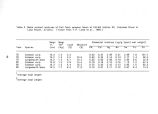| OCR Text |
Show An improvement of an unknown ( but probably low) magnitude would occur in water quality resulting from the reduction in gray- water discharges. This alternative would not affect the regulation of sewage discharges, which are already illegal, but could make enforcement easier. Possible actions to increase the monitoring and enforcement of prohibitions on sewage discharges are discussed in the section on shoreline water quality ( III. D). 11 I. E. 3. Recommended course of action. Although Alternative B is recommended, Alternative C may become necessary based on monitoring results ( and state regulatory decisions). However, the potential economic effects are significant. Any prohibition of gray- water discharge should be based on field data indicating both a need for regulation ( evidence that a negative effect exists) and the possibility of substantive water quality improvement if gray- water discharges are stopped. Alternative B would provide sufficient data to determine whether a gray- water problem exists. III. F. Water Quality of Rivers for Recreational Use III. F. 1. Statement of the problem. The five rivers in Glen Canyon NRA used for recreational purposes are the Colorado, San Juan, Escalante, Dirty Devil, and Paria Rivers. River running is the predominant activity on the Colorado and San Juan, but all the rivers are used extensively for wilderness recreation and the associated activities of wading, swimming, bathing, cooking, drinking, and fishing. The Colorado River between Glen Canyon Dam and Lees Ferry is heavily used by fishermen and commercial one- day raft tours. This is the most heavily used river segment in the NRA, receiving up to 120,000 river users a year ( these figures include fishermen, rafters destined for the Grand Canyon, and one- day tourists in Glen Canyon). The San Juan, the next most- visited river in the NRA, is used by 2,000 river runners annually. The Paria River is least visited; it is used primarily ( and increasingly) as a hiking route for people entering the Paria Wilderness Area. River recreation presents a two- fold water quality problem: ( 1) when use levels are high, the potential exists for contamination of the water by recreationists; and ( 2) with contamination comes the related problem of determining when the water is safe for recreation with minimum health risks. Tunnicliff and Brickler ( 1981) reported to the National Park Service that fecal contamination of river waters above Lees Ferry was reaching unacceptable levels, mainly as a result of contamination by humans fishing and camping on the shoreline. Since then, vault toilets have been installed along the river corridor to control the problem, but follow- up monitoring has not been carried out to assess their effectiveness. Past monitoring in the Grand Canyon and on other rivers has thoroughly documented contamination of rivers during high levels of recreational use, when the deposition of human waste is uncontrolled. 35 |








































































































